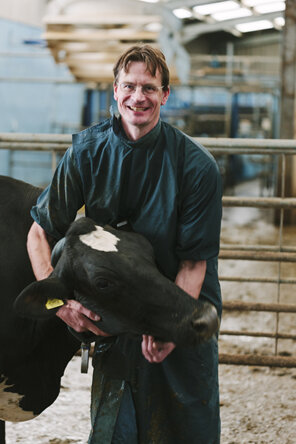
This is a new and emerging problem in New Zealand. BDD has been diagnosed in Mid Canterbury and is a serious issue. If you have any suspicion you might have this disease in your herd ring your vet as we are highly focussed on finding and treating this disease in the hope we can prevent it becoming a larger issue.
Description
Digital dermatitis is a skin disease of cattle which usually affects the skin on the bulbs of the heel. Digital dermatitis is thought to be an infection caused by bacteria because of its prompt response to topical antibiotics.
In countries where cows are housed it is common and is associated with poor hygiene, high stocking density, insufficient cubicles, and with large herds. BDD is now, however, increasingly being noticed in New Zealand.
Cattle with digital dermatitis may show signs of lameness when standing or when moving. The most commonly seen presentation is the standing animal that flicks its foot repeatedly for no obvious reason. A very high proportion of cattle with digital dermatitis may, however, show no signs of lameness.
Appearance
A typical case of digital dermatitis goes through a number of stages:
The early lesion is seen as a moist, light grey brown, exuding area with mottled hair at the back of the foot.
It has a characteristic foul odour.
Cleaning the area reveals a red raw granulating area, severely painful to the touch, but with no swelling in the adjacent tissue.
Digital dermatitis is very painful, and the majority of cows with digital dermatitis will withdraw the foot rapidly if pressure is applied to the affected area (such as water pressure from a hose).
Neglected lesions develop more chronic stages of the disease with erosion and under running of the heel horn.
Eventually the lesion may appear to heal naturally or shrink to a very small scar, but may still be a source of infection.
Diagnosis
Classical digital dermatitis is fairly easy to diagnose if you have seen it before. If you have not seen it before and if you suspect BDD it is advisable to call your vet to verify your diagnosis by taking a sample and having the laboratory confirm it.
Where it is Commonly Found
Most commonly found on the skin of rear feet, midline, just above the bulb of the heel. BDD can also be found between the digits or in the area of the coronary band. Overseas it is also known to affect other foot lesions such as sole ulcers, white line disease, and interdigital growths causing considerable pain.
Treating BDD
Appearance:
• A foul smelling sore on the skin of the foot, usually the rear foot, midline just above the bulb of the heel.
Treatment:
• The affected area is cleaned (avoiding excessive bleeding) and an antibiotic spray is applied. .
Control:
• Severe herd outbreaks can be controlled with footbaths containing antibiotic solutions.
• In infected herds, severe outbreaks can be prevented with regular hygiene in all facilities and regular foot-bathing of all stock. Good hygiene needs to be maintained.
• Ongoing control is by use of footbaths with antiseptic solutions.
Prevention
The cause is multi-factorial but prevention must concentrate on hygiene and biosecurity.
BDD is usually introduced by buying in infected cows and then spreading from cow to cow where foot hygiene is poor. Muddy entrances and exits, feed pads, and housing systems have all been implicated.
If a herd has no cases it is essential that no animal is brought in from infected herds. Be careful with cleanliness of foot paring equipment that might have been used on infected herds (vets’ and foot trimmers’ equipment).
In NZ this infection has been identified in recent years in isolated animals, and now is beginning to appear as multiple cases within herds. It is advisable if you find a case on your farm to have the entire herd checked.